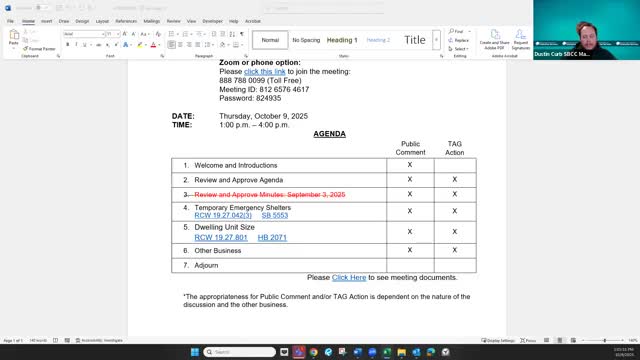TAG opens scoping for dwelling-unit-size changes under legislative mandate; members flag accessibility and cross-code alignment
October 10, 2025 | Building Code Council, Governor's Office - Boards & Commissions, Executive, Washington
This article was created by AI summarizing key points discussed. AI makes mistakes, so for full details and context, please refer to the video of the full meeting. Please report any errors so we can fix them. Report an error »

On Oct. 9, 2025, the State Building Code Councils IBC technical advisory group discussed legislative direction to revise dwelling-unit size provisions after lawmakers directed the council to act as part of the 2024-code cycle. Staff and members reviewed statute and stakeholder proposals, and identified definitions, minimum-room-area calculations and accessibility standards as priorities for further work.
Attendees referenced the bill sponsors and the bill text (the TAG noted the dwelling-unit-size work stems from legislation introduced as part of the 2023/2024 session). Several members pointed to a submitted proposal from architect David Neiman and to the National Healthy Housing Standard as reference materials. Discussion focused on how to interpret and measure "dwelling unit" versus "efficiency dwelling unit," how to count habitable-room area (70 square feet was cited as a common habitable-room threshold), and whether a single-room efficiency threshold should be aligned with the dwelling-unit standard.
TAG members also flagged cross-code alignment and unintended consequences. Participants noted that the International Residential Code (IRC) and the IBC may treat residential and multifamily provisions differently; the group said it will coordinate with the residential/multiplex TAG to avoid conflicting standards. Accessibility concerns were raised repeatedly: as units get smaller, meeting required accessible clearances and Type A/Type B accessible unit requirements could become more difficult.
Technical points raised during the meeting included: questions about minimum ceiling heights in small units; how to treat kitchens and sanitary facilities when a sleeping room also contains cooking appliances; and the need to clarify whether the statute seeks statewide mandatory amendments to the IBC, an adoptable appendix, or another approach. Members discussed related legislation on "kit homes" and the difference between short-term shelter questions and permanent dwelling-size reforms.
No formal rulemaking decisions were made. The TAG agreed to collect proposals, review submitted materials (including David Neiman's proposal and supporting analyses), coordinate with the residential-code group to align approaches, and open a public proposal window to solicit additional code-change language and evidence. Staff said they will post the proposal materials and topic summaries on the IBC tag page and aim to track revisions and decisions in a central document.
Attendees referenced the bill sponsors and the bill text (the TAG noted the dwelling-unit-size work stems from legislation introduced as part of the 2023/2024 session). Several members pointed to a submitted proposal from architect David Neiman and to the National Healthy Housing Standard as reference materials. Discussion focused on how to interpret and measure "dwelling unit" versus "efficiency dwelling unit," how to count habitable-room area (70 square feet was cited as a common habitable-room threshold), and whether a single-room efficiency threshold should be aligned with the dwelling-unit standard.
TAG members also flagged cross-code alignment and unintended consequences. Participants noted that the International Residential Code (IRC) and the IBC may treat residential and multifamily provisions differently; the group said it will coordinate with the residential/multiplex TAG to avoid conflicting standards. Accessibility concerns were raised repeatedly: as units get smaller, meeting required accessible clearances and Type A/Type B accessible unit requirements could become more difficult.
Technical points raised during the meeting included: questions about minimum ceiling heights in small units; how to treat kitchens and sanitary facilities when a sleeping room also contains cooking appliances; and the need to clarify whether the statute seeks statewide mandatory amendments to the IBC, an adoptable appendix, or another approach. Members discussed related legislation on "kit homes" and the difference between short-term shelter questions and permanent dwelling-size reforms.
No formal rulemaking decisions were made. The TAG agreed to collect proposals, review submitted materials (including David Neiman's proposal and supporting analyses), coordinate with the residential-code group to align approaches, and open a public proposal window to solicit additional code-change language and evidence. Staff said they will post the proposal materials and topic summaries on the IBC tag page and aim to track revisions and decisions in a central document.
View full meeting
This article is based on a recent meeting—watch the full video and explore the complete transcript for deeper insights into the discussion.
View full meeting
